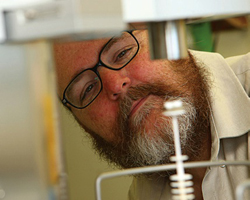Pioneering better materials
By Mark Campbell

NSERC and Pratt & Whitney Canada partner on new industrial Research Chair
Dr. Stephen Corbin (BEng‘87, MASc‘88) laughs when asked what it’s like to be a pioneer. “It’s cool,” he concedes. “It’s nice knowing you’ve developed something no one else has thought of doing, and to be recognized not just with citations of your papers, but also by a company like Pratt & Whitney Canada.”
What Dr. Corbin has developed is a unique application for thermal analysis tools such as differential scanning calorimeters and laser flash technology. For almost 20 years, many of which were spent at the University of Waterloo, he has used these tools to explore transient liquid phase sintering (TLPS) and bonding (TLPB) – fundamental components in the manufacturing process. Both the microelectronics packaging and automotive industries have benefitted from his work.
Now, as the NSERC/Pratt & Whitney Canada Industrial Research Chair with the Department of Civil and Resource Engineering at Dalhousie University,? Dr. Corbin is expanding his manufacturing processes research to take on his biggest challenge yet: the aerospace industry. If the five-year research project he has just embarked on is successful, it will not only revolutionize how airplane engines are manufactured, it will also have impacts for Canada’s economy and environment.
To understand the magnitude of what Dr. Corbin hopes to achieve, a bit of background is in order. For years, the aerospace industry has manufactured engine parts by taking large blanks of titanium or nickel-based superalloys, then cutting out required shapes. By Dr. Corbin’s estimates, sometimes up?to 90% percent of material is cut away. “That’s a considerable waste of material and energy, but it’s also expensive because you have to machine away that material, so it’s environmentally unfriendly.”
Companies like Pratt & Whitney Canada have been exploring near net, or additive, manufacturing – building complex engine parts from smaller components. These components are sintered, or formed, and then joined together by brazing, to create a completed engine part. Yet the tensile strength of these brazed joints has nothing on the traditional method? of manufacturing when it comes to withstanding the demands of the hot section of the engine.
That’s where Dr. Corbin comes in. By studying superalloy bonding as it occurs, he hopes to identify changes to the process that will consistently result in stronger, better-brazed joints.
“Engine manufacturing is a very mature field,” says Dr. Corbin. “Costs are pretty much fixed if you use traditional methods, so if you want to be cost competitive, particularly on a global scale, you have to be innovative. If ?this research works, Pratt & Whitney Canada will take near net processing?to more parts in the hot section of the engine, allowing them to reduce their manufacturing costs and reduce the environmental impact of production.”
Says Don McIntosh, Senior? Fellow – Manufacturing Technology, Manufacturing & Tooling Engineering, Pratt & Whitney Canada: “The work Corbin is doing aligns with our objective to use less energy and make more parts. We don’t just want to be known for the best gas turbine engines in the world. We want to be known for the best gas turbine engines for the world. The less waste in the value stream, the better it is for the environment.”
Additionally, 85% of research funds invested by Pratt & Whitney Canada and NSERC will go to hiring and training professionals in the field of engine manufacturing. “That’s probably the most important deliverable of this undertaking,” says McIntosh. “Dr. Corbin is leveraging bright young minds that will go on to extend this research into other forms of manufacturing, resulting in more cost-competitive Canadian companies.”
In addition to his work for Pratt & Whitney Canada, Dr. Corbin is involved in several other research projects. He’s exploring aluminum brazing of automotive parts in collaboration with DANA-Long Manufacturing and Professor Mary Wells of the University of Waterloo. He’s leading a project involving Wells, Dalhousie professors Paul Bishop and Kevin Plucknett, Wescast Industries, and Kingston Process Metallurgy on the development of low-cost titanium parts for automotive manufacturing. And he’s exploring the use of laser cladding to repair titanium parts for the aerospace industry in a project led by Dalhousie professor Paul Bishop for Boeing Inc. All of these projects have the potential to drive similar benefits as his work for Pratt & Whitney Canada.
But what really excites Dr. Corbin?is the opportunity to conduct this research at Dalhousie. “That was a major consideration when the Dean of Engineering, Joshua Leon offered me this opportunity over two years ago. This is my hometown, the university where I did metallurgical engineering, and my father did his civil engineering degree here in the 1940s. So it’s great to be back here.”
If Dr. Corbin is successful and his research allows Pratt&Whitney Canada to extend sintering and brazing to the hot section of the engine, what then? “I expect we may have a lot of questions left, even if we have solved the main problem,” he says. “That may generate other opportunities for research on behalf of Pratt & Whitney Canada. Any time you understand the fundamentals better, there’s an opportunity to do something more unique and novel.”
Which means, five years from now, someone else will likely be asking him how it feels to be a pioneer.